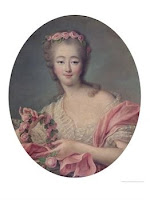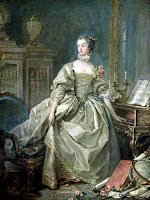
Probably due to some snafu on my part, our guest blogger for today is Missing in Blogland.
Shudder!!
So Sorry. To console you, I’ll announce that The Unlacing of Miss Leigh is available on eHarlequin and with other online vendors. I’m just saying……
To console you, I’ll announce that The Unlacing of Miss Leigh is available on eHarlequin and with other online vendors. I’m just saying……
Diane
So, last week I turned in a book to Grand Central Publishing, came up with a new contract at Harlequin Historicals, am now thinking about Christmas for a new novella, and have eaten far too many Reese’s Peanut Butter Eggs while sniffling as I watched the last scene of North and South over and over. I need to get motivated again, and what better way than with yummy-smelling perfumes.
 One of my favorite books in the “life at Versailles” pile in my writing space (as opposed to the “life in the Elizabethan theater” pile, or “life in the Regency” pile) is Elisabeth de Feydeau’s A Scented Palace. It’s a biography of Marie-Antoinette’s favorite perfumier, Jean-Louis Fargeon, but it’s also a description of how perfumes were made in the period, how essential oils were extracted, what scents were “fashionable” at what time. It’s a fascinating story, and when I visited Versailles last autumn I loved trying to imagine how these perfumes smelled.
One of my favorite books in the “life at Versailles” pile in my writing space (as opposed to the “life in the Elizabethan theater” pile, or “life in the Regency” pile) is Elisabeth de Feydeau’s A Scented Palace. It’s a biography of Marie-Antoinette’s favorite perfumier, Jean-Louis Fargeon, but it’s also a description of how perfumes were made in the period, how essential oils were extracted, what scents were “fashionable” at what time. It’s a fascinating story, and when I visited Versailles last autumn I loved trying to imagine how these perfumes smelled.
And now I don’t have to imagine any more! DSH perfumes (Dawn Spencer Hurwitz–see her fabulous website here) has a new collection called The Perfumed Court. These scents are based on Fargeon’s own recipes, and made with all-natural ingredients that were available in the 18th century (except for the animalic notes like ambergris and musk, which are illegal now). When I read about these scents, I had to run out and order some samples immediately.
I didn’t order all of them, just the ones that appealed to me the most. Here are the results of much rapturous sniffing and sampling! (Warning: these results are entirely amateur and individual!)
 Eau de la Favourite: Based on a scent created for Madame du Barry it opens with orange and lemon flowers, very fresh, and quickly becomes a powedery iris with a hint of violet leaf (which adds smoothness), and even a hint of cognac (or at least that what it smells like to me!). This is a light, fun smell, like a summertime party.
Eau de la Favourite: Based on a scent created for Madame du Barry it opens with orange and lemon flowers, very fresh, and quickly becomes a powedery iris with a hint of violet leaf (which adds smoothness), and even a hint of cognac (or at least that what it smells like to me!). This is a light, fun smell, like a summertime party.
Eau de Coquette: This was also Madame du Barry’s, but unlike Favourite it’s made for a winter’s evening of seduction! It’s very rich, opening with notes of angelica and nutmeg, then going into rose, jasmine, orange flowers, and ambergris (the faux kind).
 Cyprian: This one is kind of unusual, as it’s derived from a recipe for wig pomade! That sounds weird, I know, but it’s suprisingly fresh and powdery, not too sweet or cloying. It opens with Bergamot and green herbs, moving into that violet (which I love), and ending with a sort of citrus-powder.
Cyprian: This one is kind of unusual, as it’s derived from a recipe for wig pomade! That sounds weird, I know, but it’s suprisingly fresh and powdery, not too sweet or cloying. It opens with Bergamot and green herbs, moving into that violet (which I love), and ending with a sort of citrus-powder.
Reinette: Madame de Pompadour’s perfume! The heart is a hyacinth (said to be her favorit flower), with notes of carnation and tuberose. Very floral and romantic.
 Mille-fleurs bouquet: is also Pompadour’s! The title says it all–lots of flowers, a huge bouquet. The opening lavender/lemon cleanness, moves into roses, vanilla, geranium leaf, violet, vetiver, and probably lots of things I can’t quite make out…
Mille-fleurs bouquet: is also Pompadour’s! The title says it all–lots of flowers, a huge bouquet. The opening lavender/lemon cleanness, moves into roses, vanilla, geranium leaf, violet, vetiver, and probably lots of things I can’t quite make out…
 Eau de Trianon: My favorite of all! I loved exploring the Trianon and its beautiful gardens, and this perfume seems to encapsulate it so well. It’s a soft green/floral herbal, with notes of rose, jasmine, orris root (iris), and violet. Very summery and elegant. I think I’ll buy a full bottle of this one!
Eau de Trianon: My favorite of all! I loved exploring the Trianon and its beautiful gardens, and this perfume seems to encapsulate it so well. It’s a soft green/floral herbal, with notes of rose, jasmine, orris root (iris), and violet. Very summery and elegant. I think I’ll buy a full bottle of this one!
I had tremendous fun imagining what the ladies who originally wore these scents would have been wearing, and where they would have been going, as they sat at their dressing tables and dabbed on their perfume from gorgeous bottles.
Who are some of your favorite historical women? What perfumes do you imagine for them? Or what’s your own favorite scent? (I always like to give the heroines I’m writing their own perfumes, too!)
 Don’t get me wrong. I’m still shooting people. I’m just doing it with dueling pistols and muskets instead of MP5s and Sig-Sauers.
Don’t get me wrong. I’m still shooting people. I’m just doing it with dueling pistols and muskets instead of MP5s and Sig-Sauers.
My life used to be so simple. I wrote modern-day romance, romantic suspense, and straight suspense. It was fun. It was satisfying. As a trauma nurse with a forensic background, it was relatively easy to research. Call a friend who’s a cop. Call a friend who’s a medical examiner. (Yes, I have good friends…) And if that wasn’t enough, I figured out a way to play with it. I took Police Citizen’s Academy, Death Investigation Training, and FBI Citizen’s Academy (site of my proudest achievement! Amid all the cop and military types, I won a blue ribbon in the MP5. I keep the medal hanging in my kitchen so my children never forget).
 But for a long time, I’ve had this itch that SWAT training didn’t satisfy. I blame it on Melinda Helfer, legendary reviewer at RT. She saw I had developed a fondness for Regency romance, and said “Eileen, you need to write a Regency!” I laughed. You see, I long ago resigned myself to the fact that I suck at research. The kind you have to wade into books to get, since anybody who knew anything about it was already dead. I was a trauma nurse–I had no idea how to work in a library!
But for a long time, I’ve had this itch that SWAT training didn’t satisfy. I blame it on Melinda Helfer, legendary reviewer at RT. She saw I had developed a fondness for Regency romance, and said “Eileen, you need to write a Regency!” I laughed. You see, I long ago resigned myself to the fact that I suck at research. The kind you have to wade into books to get, since anybody who knew anything about it was already dead. I was a trauma nurse–I had no idea how to work in a library!
Not only that, I was finally diagnosed with ADD (I seem to be the last to know), which means organizing all that information and picking out the pertinent bits was way beyond me. So, there I was, happily decimating the population of St. Louis in a series of suspense stories under the name Eileen Dreyer, and this idea for a trilogy of Regency-era romances came to me full-blown (thanks, Melinda!). It wouldn’t leave me alone. It talked to me. The characters took shape. They demanded that attention be paid. But I kept saying, “No, no, later. I have things to do.”
Funny how that can be resolved. For me, the suspense market temporarily dried up. And my new heroines, who I had dubbed The Three Graces, said, “Really what you want to learn about is Waterloo. And early 19th century undergarments!” I protested fruitlessly. “But I can’t call anyone who was there! I’d have to read a book!”
And God said, “Let there be the Internet. And Wellbutrin.” (Which gave me the focus to actually read non-fiction books. My new favorite is Dancing Toward Waterloo by Nick Ffolkes). Clever, isn’t She? I can’t tell you how much fun I’m having. History really does fascinate me. Not only that, I’ve become a card-carrying member of the Anachronism Club, which means I pride myself on my acquaintance with Regency mores and habits.
And, since the first book begins the night before Waterloo, I still get to decimate populations. I still get to have suspense and sex, and the absolutely accurate research that is my hallmark over in Suspenseland.
And early 19th century undergarments.
How cool is that?
You can visit Eileen’s website (and learn more about her books!) here…